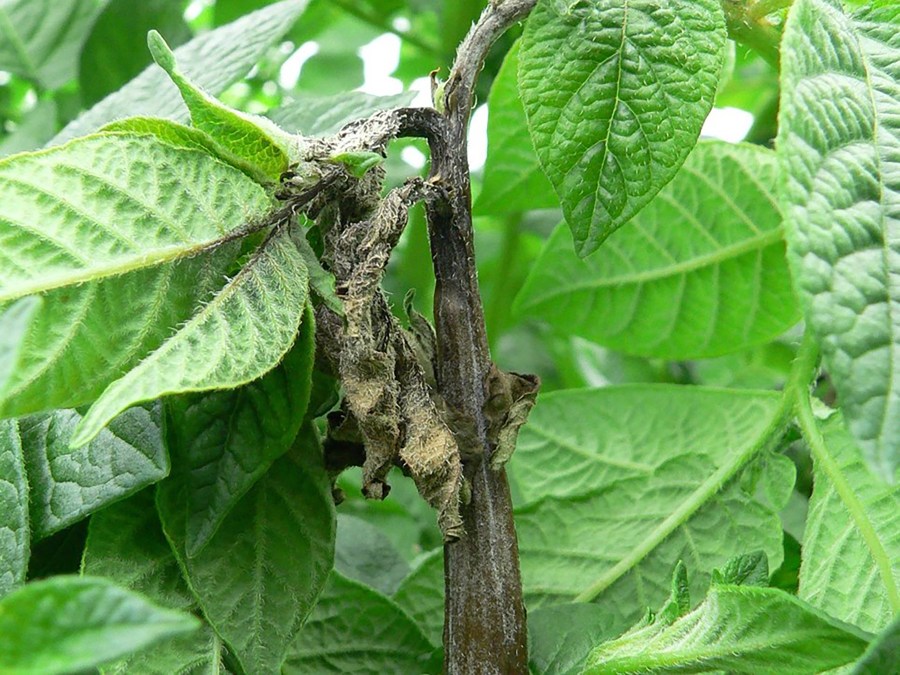Lessons from Europe point to how to control resistant strains of late blight, but the level at which this demands growers to engage with integrated resistance management worries experts. CPM reports…
“We’ll have to find new ways to control late blight, including the use of decision support systems and in-crop monitoring.” TOM ASTILL
By Rob Jones
The spread of late blight strains resistant to some of the most frequently used fungicide groups and the risk these pose to crop protection programmes is causing concern, according to researchers and product manufacturers.
Although fungicide resistance isn’t a new phenomenon, earlier instances such as the spread of fluazinam-resistant 37_A2 (‘dark green 37’) and metalaxyl-resistant 13_A2 (‘blue 13’), were contained with reasonable ease through changes in application practices. But it’s the emergence of strains with resistance to CAA fungicides such as mandipropamid, and OSBPI fungicides such as oxathiapiprolin, which arguably pose a challenge of a different magnitude.
“Newer genotypes EU_43_A1 and EU_46_A1 have demonstrated resistance to both CAA and OSBPI fungicides, and sub-populations of some newer genotypes are more virulent, able to overcome what have been identified as major resistance genes of cultivars.
“This is concerning because these genes are central to breeding varieties with improved resistance,” stresses Bayer’s Tom Astill.
Breeding innovation and plant protection product development are long-term programmes with progress in one area often reliant with that in another, he adds. “The loss of resistance genes seen as integral to cultivar development undermines efforts to preserve fungicide efficacy for future seasons.
“We’ll have to find new ways to control late blight, including through the wider use of decision support systems and in-crop monitoring tools, while continuing to practice responsible resistant management,” urges Tom.
To highlight the threat that these strains pose and the response required to contain them, Bayer recently hosted a seminar for growers and agronomists. The role of infected seed in enabling the spread of these new strains was among the key topics covered.
Research in 2011 (Zellner et al.) found that of the seed potato batches tested, on average 11% carried a latent late blight infection. In today’s context, EU_46_A1 has been detected in Poland and given around 80% of the seed potatoes planted there are supplied by Germany and the Netherlands, transmission of late blight in seed could explain how these new strains have spread so far so quickly, other than by air-borne spore transmission.
In the UK, growers should be cognisant about seed transmission and continue to manage primary inoculum sources by controlling volunteer potatoes and destroying or covering out grade piles, says Tom. “Ensuring crops remain protected in the face of these new threats means mixing modes of action and using active substances recognised to give sufficient protection.
“For instance, suggestions that solely including cymoxanil with mandipropamid as a means of combating CAA-resistant 43_A1 is not responsible, as although cymoxanil is another mode of action with activity on late blight, it will give only 2-3 days of protection which is insufficient,” he reminds.
“It’s similarly important to maintain dose rates; the QiI amisulbrom is a popular mixing partner for CAA and OSBPI fungicides but be sure to maintain the full application rate. Bayer glasshouse trials indicate that amisulbrom at 60% dose will give 20-25% control of EU_43_A1 isolates with resistance to both CAA and OSBPI fungicides. At the full rate, this increased to more than 70%.”
According to Tom, resistance management guidelines produced by Aarhus University have resulted in a dramatic fall in the frequency of EU_43_A1 since 2023. “Up until 2022, growers in Denmark made regular applications of mandipropamid, often up to six times in the programme.
“They’ve since limited its use to just two applications and always in a mix with a reliable partner. Also there have been fewer applications of mandipropamid at the start of the season to reduce early selection for EU_43_A1,” he explains.
To protect the efficacy of Infinito (fluopicolide+ propamocarb) and other propamocarb products, Bayer has published updated guidance for the 2025 season.
Tom says propamocarb continues to be effective against late blight with no reports of resistance. “To reduce the chances that this might change, propamocarb should always be applied in mixturewith another fungicide with sufficient activity on Phytophthora infestans and in alternation with fungicides from a different cross-resistance group.”
Furthermore, Bayer advises that no more than 6060g propamocarb is applied per hectare per crop in 2025.
From a grower’s perspective, the spread of late blight strains resistant to some widely used fungicides has added cost and complexity to fungicide strategies. For Myles Forber, technical manager at Chatteris-based grower A & EG Heading Ltd, this has increased the agronomic risks at a time when business confidence is already under pressure.
“Late blight poses a significant crop protection challenge, but while it’s not the biggest threat we face, the loss of fungicides and the spread of resistant strains make managing it more difficult and expensive,” he says.
Miles adds that it’s the nature of the disease too that causes concern, especially when seeking to balance fungicide applications within a standard seven-day irrigation schedule.
This is because EU_36_A2 – the dominant strain of late blight in England – can produce more than 800,000 spores per cm2 of lesion every seven days. A latent period – the duration between when a host is infected and symptoms appear, becoming infectious – of just four days means once an infection is created, it quickly produces spores.
“Blight control during the tuber bulking period is the most challenging because of the crop’s demand for water. We can’t afford to stop irrigating to spray crops, so applications during this period have to be well-timed and robust,” comments Miles.
“There’s also the need to recognise that other crops around us can serve as a reservoir for infection. There’s a large area of irrigated potatoes on the Fen and blight spores have been known to be carried great distances on the wind, so we can’t afford to think of our own crops in isolation,” he stresses.
Of particular concern is the resistant strain EU_46_A1 which was found in Wales and Scotland in 2024. Sensitivity screening revealed resistance to the OSBPI mode of action group featuring oxathiapiprolin (as in Zorvec). Another concern is EU_43_A1, which although yet to be detected in Great Britain, is resistant to CAA fungicides such as mandipropamid (as in Revus).
Managing the threat posed by new and established strains comes down to having a balanced programme that ensures no one mode of action is exposed, believes Miles. “I’m fortunate to have enough mancozeb to serve as a mixer with straights such as Revus or those active substances with single site modes of action, notably QiI fungicides, such as amisulbrom and cyazofamid.
“What we use in its place after this season remains uncertain. Privest (ametoctradin+ potassium phosphonates) may fill the space in the early season, but after this, we don’t know,” he says.
There are cost implications of having to add a non-CAA mode of action such as mancozeb to Zorvec Entecta (oxathiapiprolin+ amisulbrom) and Revus, but the requirement to protect these modes of action for future seasons means many growers recognise it as necessary.
A positive of this however, is that there’s scope to incorporate more applications of Ranman Top (cyazofamid) or other QiI fungicides in alternation with Infinito (fluopicolide+ propamocarb) in the final stages of the season when the anti-sporulant properties of propamocarb are useful in limiting the risk of tuber blight.
“I’m already using the maximum number of four Infinito sprays. With no known resistance this has the advantage of not requiring a third mode of action which also makes it financially competitive,” explains Miles.
“In contrast, Ranman Tophas to be mixed with partner products such as mancozeb, cymoxanil, fluazinam or propamocarb to guard against resistance.”
This article was taken from the latest issue of CPM. Read the article in full here.
For more articles like this, subscribe here.
Sign up for Crop Production Magazine’s FREE e-newsletter here.




